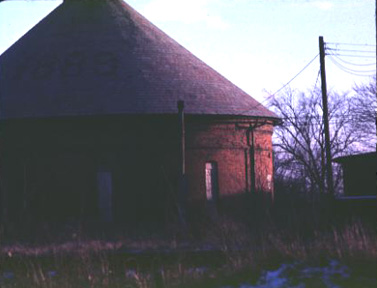Gas-holder BuildingSouth Main Street, 1889 |

This battered relic of the gaslight era is Oberlin's best example of industrial functionalism in nineteenth-century architecture. It is also a reminder of the quick pace of technological change in urban America.
It was built with some 300,000 bricks in 1889 by the Oberlin Gas Lighting Company (Albert H. Johnson, president) as a storage holder for locally manufactured coal gas. It made possible a huge expansion of capacity for an enterprise which Samuel Plumb had launched back in 1858. Oberlin was the first town in the area to enjoy gaslit streets. But in the 1880s gas began yielding to electricity as the main source of public illumination. Oberlin moved toward conversion with some caution. "Many of the cities are having such sad experiences with electricity," the local paper noted, "that the smaller towns which have been debating the matter of adopting that system of lighting will doubtless be content with the old and less dangerous methods."
Was electricity here to stay? What were the costs? Should the town wait until it could build its own public power plant? The village council wrestled earnestly with these issues for years. Meanwhile Albert H. Johnson, who had not become a millionaire by fighting Progress, proceeded with his own quiet conversion. His Oberlin Gas Lighting Company turned into the Oberlin Gas & Electric Company, the wires were strung, and the contract signed. On the night of September 28, 1893, Oberlin's streets glowed with Johnson's electric lights.
Although coal gas continued to be manufactured for heating, the exploitation of natural gas deposits in northern Ohio around the turn of the century soon made the older fuel obsolete, and the gasworks buildings began their slow decay.
(Blodgett 137-38)